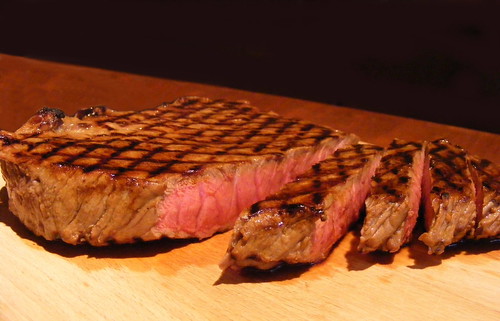On the numerous occasions I’m asked how best to ensure success in the kitchen, my two part answer is always the same:
Rule #1: Fresh Ingredients=Less Work
If it’s suffering in the quality department, you may be able to eke a reasonable meal out of it. In fact, you may be able to impress someone. But let’s face it. If it’s impeccably fresh, it’s going to be easier. A quick sear, a light poach, or simply no cooking at all–just a couple drops of olive oil and a few grains of sea salt–are often all it takes to elevate a pristine piece of fish to a sublime meal. If every ingredient in your recipe is at its prime, everything else seems to fall into place. Slicing will be easier. Flavors will be at peak. Textures will be perfect. And your job–to prepare, heat or chill, and assemble your final product–will be all the more easy.
Rule #2: Get A Good Meat Thermometer
Cooking blind is just a bad idea. You don’t slice a tomato and then toss it into a sauce without inspecting it inside and out for spoilage. You don’t serve an open packet of crackers to dinner guests without making sure they’re not stale. Likewise, you should be as mindful about the inside of that expensive piece of meat or fish you’re about to place on your serving platter. A couple pounds of good quality steak will run you $20-30 at the butcher shop. And then you plan to throw them onto an infernal grill and “hope” you get the medium-rare doneness you like? STOP! If you’re eating expensive steak, spend another few bucks and get yourself a decent meat thermometer. In fact, don’t buy any more meat until you do.

This rule goes doubly for you folks who want to trim every last piece of fat from your food before cooking. I certainly won’t discourage this practice from a health perspective, but you need to remember that much like Uncle Jimmy’s high body fat percentage keeps him warmer than you in the winter, external fat protects meat from the heat of the flame.
Internal fat–such as the marbling you see throughout the muscle fibers of a steak–has a similar benefit, but it also breaks down during cooking and helps to baste the meat from within, keeping it moist. That’s why a pot roast is still moist after three hours of cooking. But with a super-lean piece of protein such as chicken breast, you’re running the risk of the dry meat that so many home-grillers fear if you don’t watch your temps.
The meat thermometer will save you. The one I keep on hand for me and my staff to use is the Taylor 9847N, available for under $12 at Amazon.com. It’s fast, waterproof and you can calibrate it, meaning you won’t wonder whether it’s accurate or not. The other reason you want one? Well, it goes back to Rule #1: if it’s fresh, it’s less work…unless you over- or undercook it. A digital meat thermometer will ensure that your quality ingredients are perfectly cooked, saving you the work of trying to correct a mistake.
Finally, we can’t ignore the question of safety. Even the freshest and highest-quality ingredients are sometimes implicated in food-borne illness outbreaks; most recently, we’ve seen ground turkey, strawberries and bean sprouts fingered, and in the not-so-distant past, spinach and lettuce were the culprits. Generally these risks can be lessened by cooking to a minimum temperature; of course, you can’t determine the temperature of anything without a thermometer. Plus, if you guesstimate or err on the side of caution, you’re taking the risk that the taste of your end product will suffer as a result.
I recently came across a post on one of my favorite blogs, “Meathead,” which is hands-down the best rundown of proper food handling I’ve ever seen. His article includes a link to a printable .pdf of the most sensible meat/fish doneness chart you can find, and in a sometimes contaminated culinary world, this chart’s availability alone is reason enough to read the whole article. Print it out and stick it to your fridge. Keep one by the grill. Take it camping.
And veggies? Well, the article also touches upon the safety of produce and some precautions and techniques you can implement to reduce your chances of food borne illness. More importantly, his sensible advice on balancing our desire for a food cooked the way we like it helps us have our cake and eat it too…without the specter of the “24-hour flu” hanging over our heads. You’ll even get a primer on sous-vide cooking–the technique you’ve always heard about on “Top Chef” and never really understood.
So if taste comes first, your starting point should still be the freshest foods you can find. Whether it’s local and organic or supermarket and conventional, the best foundation for a satisfying meal–and its preparation–is starting with quality product. And with a modest investment in a simple digital thermometer, your workload, your risk and your frustration levels are all but eliminated.